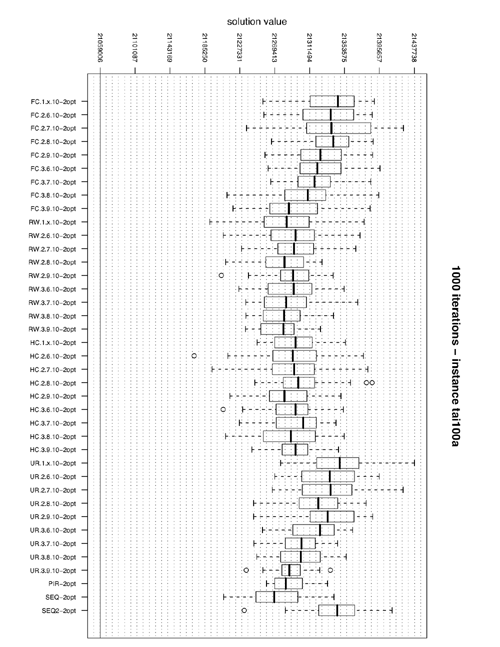Difference between revisions of "Repository of scripts used by IRIDIA members"
From IridiaWiki
Jump to navigationJump to search| (2 intermediate revisions by the same user not shown) | |||
| Line 10: | Line 10: | ||
| |
| |
||
|-+ out (contains the outputs of the trial) |
|-+ out (contains the outputs of the trial) |
||
| + | | | |
||
| + | | |-+ algorithm1 |
||
| + | | | | |
||
| + | | | |-+ instance1 |
||
| + | | | | |
||
| + | | | |-+ instance2 |
||
| + | | | |
||
| + | | |-+ algorithm2 |
||
| + | | | |
||
| + | | |-+ instance1 |
||
| + | | | |
||
| + | | |-+ instance2 |
||
| |
| |
||
|-+ sh (contains the script to launch the experiments) |
|-+ sh (contains the script to launch the experiments) |
||
| |
| |
||
|-+ src (contains the sources of the algorithms) |
|-+ src (contains the sources of the algorithms) |
||
| + | | | |
||
| + | | |-+ algorithm1 |
||
| + | | | |
||
| + | | |-+ algorithm2 |
||
| |
| |
||
|-+ analysis (contains the R script to boxplot the experimental data) |
|-+ analysis (contains the R script to boxplot the experimental data) |
||
Latest revision as of 21:49, 7 January 2007
Max's scripts
When testing different algorithms on some combinatorial optimization problem, I usually organize the data on my machine according to a same schema. Basically I create the following structure of directories to store sources, problem instances, output data, executables and scripts.
+ main_project_folder | |-+ bin (contains the executables of the algorithms) | |-+ instances (contains the problem instances) | |-+ out (contains the outputs of the trial) | | | |-+ algorithm1 | | | | | |-+ instance1 | | | | | |-+ instance2 | | | |-+ algorithm2 | | | |-+ instance1 | | | |-+ instance2 | |-+ sh (contains the script to launch the experiments) | |-+ src (contains the sources of the algorithms) | | | |-+ algorithm1 | | | |-+ algorithm2 | |-+ analysis (contains the R script to boxplot the experimental data)
Boxplot of solution values by algorithm
I organize the data in the following way:
in the file optimal_values.txt I put the best-known solution values for the problem instances I'm testing
instance optimum sko100a 152002 sko100e 149150 tai100a 21059006 tai100b 1185996137
in the files algorithms.txt I put the algorithms details
idalgo topo schema ls type number_of_cpus PIR-2opt PIR PIR 2 Par 2 PIR-ts PIR PIR 3 Par 2 SEQ-2opt SEQ SEQ 2 Par 2 SEQ-ts SEQ SEQ 3 Par 2 SEQ2-2opt SEQ SEQ 2 Par 2 SEQ2-ts SEQ SEQ 3 Par 2 HC.1.x.10-2opt HC 1.x.10 2 Par 2 HC.2.6.10-2opt HC 2.6.10 2 Par 2 HC.2.7.10-2opt HC 2.7.10 2 Par 2
in the files algorithm_factors_instance-size_cut-time.txt I record the history of the search of the algo for the instance
idalgo cpu_id instance try best time iteration HC.1.x.10-2opt 0 sko100a 1 155254 0.35 1 HC.1.x.10-2opt 0 sko100a 1 154162 0.35 1 HC.1.x.10-2opt 0 sko100a 1 154050 0.35 1 HC.1.x.10-2opt 0 sko100a 1 153684 2.69 8 HC.1.x.10-2opt 0 sko100a 1 153508 3.24 10 HC.1.x.10-2opt 0 sko100a 1 153396 3.24 10 HC.1.x.10-2opt 0 sko100a 1 153344 3.24 10 HC.1.x.10-2opt 0 sko100a 1 153092 3.52 11 HC.1.x.10-2opt 0 sko100a 1 153062 3.75 12
In order to produce boxplots like the one above you can look at the R source used to produce it.
optimal_values<-read.table("optimal_values.txt",header=TRUE)
resPIR2OPT<-read.table("parallel_independent_2-opt_100_1000.txt",header=TRUE)
resSEQ2OPT<-read.table("sequential_2-opt_100_2000.txt",header=TRUE)
resSEQ22OPT<-read.table("sequential2_2-opt_100_1000.txt",header=TRUE)
resHC1x102OPT<-read.table("hc.1.x.10_2-opt_100_1000.txt",header=TRUE)
resHC26102OPT<-read.table("hc.2.6.10_2-opt_100_1000.txt",header=TRUE)
resHC27102OPT<-read.table("hc.2.7.10_2-opt_100_1000.txt",header=TRUE)
resHC28102OPT<-read.table("hc.2.8.10_2-opt_100_1000.txt",header=TRUE)
resHC29102OPT<-read.table("hc.2.9.10_2-opt_100_1000.txt",header=TRUE)
resHC36102OPT<-read.table("hc.3.6.10_2-opt_100_1000.txt",header=TRUE)
resHC37102OPT<-read.table("hc.3.7.10_2-opt_100_1000.txt",header=TRUE)
resHC38102OPT<-read.table("hc.3.8.10_2-opt_100_1000.txt",header=TRUE)
resHC39102OPT<-read.table("hc.3.9.10_2-opt_100_1000.txt",header=TRUE)
resRW1x102OPT<-read.table("rw.1.x.10_2-opt_100_1000.txt",header=TRUE)
resRW26102OPT<-read.table("rw.2.6.10_2-opt_100_1000.txt",header=TRUE)
resRW27102OPT<-read.table("rw.2.7.10_2-opt_100_1000.txt",header=TRUE)
resRW28102OPT<-read.table("rw.2.8.10_2-opt_100_1000.txt",header=TRUE)
resRW29102OPT<-read.table("rw.2.9.10_2-opt_100_1000.txt",header=TRUE)
resRW36102OPT<-read.table("rw.3.6.10_2-opt_100_1000.txt",header=TRUE)
resRW37102OPT<-read.table("rw.3.7.10_2-opt_100_1000.txt",header=TRUE)
resRW38102OPT<-read.table("rw.3.8.10_2-opt_100_1000.txt",header=TRUE)
resRW39102OPT<-read.table("rw.3.9.10_2-opt_100_1000.txt",header=TRUE)
res<-rbind(resRW1x102OPT,resRW26102OPT,resRW27102OPT,resRW28102OPT,resRW29102OPT,
resRW36102OPT,resRW37102OPT,resRW38102OPT,resRW39102OPT,resHC1x102OPT,resHC26102OPT,
resHC27102OPT,resHC28102OPT,resHC29102OPT,resHC36102OPT,resHC37102OPT,resHC38102OPT,
resHC39102OPT,resPIR2OPT,resSEQ2OPT,resSEQ22OPT)
linstance<-levels(res$instance)
res.split<-split(1:nrow(res), list(res$instance, res$try, res$idalgo), drop=TRUE)
min.list <- lapply(res.split, function(x){
x[match(min(res$best[x]), res$best[x])]
})
# matches return the first among all the values with min best!!!
# so is not the one with minimal time
min.vector <- unlist(min.list)
bestalgo<-res[min.vector,]
bestalgo.split <- split(1:nrow(bestalgo), bestalgo$instance, drop=TRUE)
for (i in (1:length(bestalgo.split)))
{
bestalgo.vector <- unlist(bestalgo.split[i])
bestalgo.temp <- bestalgo[bestalgo.vector,]
l<-split(as.double(bestalgo.temp$best),bestalgo.temp$idalgo)
epsfile=paste(linstance[i],"_1000.eps",sep="")
postscript(file=epsfile,onefile=TRUE,horizontal=TRUE)
par(mar=c(5,5,5,3),cex.axis=0.7,las=2,mgp=c(4, 1, 0))
title_plot=paste("2 CPU - 1000 iterations - instance ",linstance[i],sep="")
boxplot(l,xlab="",ylab="solution value",names=c(levels(bestalgo$idalgo)),main=title_plot,
yaxt="n",ylim=c(min(min(bestalgo.temp$best),optimal_values[optimal_values$instance==linstance[i],]$optimum),
max(bestalgo.temp$best)))
axis(2, seq(from=min(min(bestalgo.temp$best),optimal_values[optimal_values$instance==linstance[i],]$optimum),
to=max(bestalgo.temp$best),length.out=10))
abline(h=optimal_values[optimal_values$instance==linstance[i],]$optimum)
grid(nx=0, ny=55,col="gray5")
dev.off()
}
